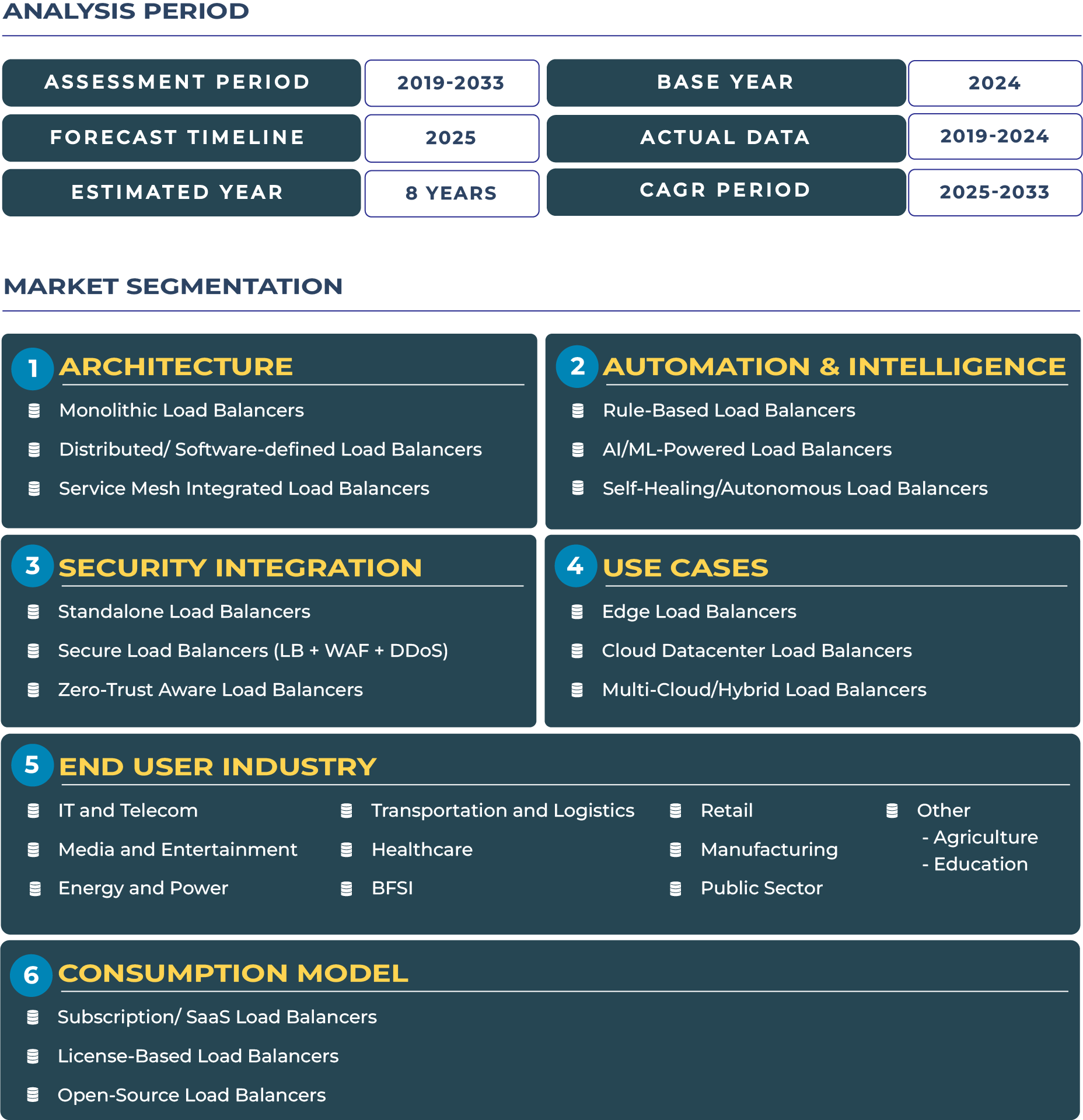Report Format:
![]()
![]() |
Pages: 110+
|
Pages: 110+
Vietnam Cloud Load Balancers Market Outlook: Startup-Led Acceleration Powering Digital Scalability
Vietnam has emerged as one of Southeast Asia’s fastest-growing digital economies, fueled by its dynamic startup ecosystem, youthful workforce, and strong foreign investment inflows. This transformation is accelerating demand for the Vietnam Cloud Load Balancers Market, which is forecast to grow from USD 18.5 million in 2025 to USD 102.5 million by 2033, achieving a CAGR of 23.9%. The surge is driven by SMEs and startups scaling digital platforms across e-commerce, fintech, and SaaS, where distributed and developer-friendly load balancing architectures are central to maintaining reliability, scalability, and efficiency. Vietnam’s strategic position as a cost-efficient innovation hub makes cloud load balancing critical for ensuring that rapid growth translates into sustainable performance.
Key Growth Drivers Strengthening Vietnam Cloud Load Balancers Industry Trajectory
One of the most significant enablers is Vietnam’s youthful, tech-savvy population, which forms both the consumer base and developer talent pool for cloud-driven businesses. Startups, particularly in fintech, logistics, and online services, are fueling heavy reliance on distributed and software-defined load balancers to handle fast-scaling digital traffic. Rapid cloud adoption, supported by foreign investors and regional accelerators, positions Vietnam as an emerging hub for SaaS and e-commerce innovation. Furthermore, the expansion of developer talent pools—often trained through programs by local universities and associations such as the Ministry of Information and Communications—creates a favorable ecosystem where advanced cloud operations can scale with agility. Together, these drivers highlight how the cloud load balancers ecosystem in Vietnam is being shaped by entrepreneurial energy and technological readiness.
Constraints Hindering Market Scalability and Operational Excellence
While momentum is strong, the Vietnam Cloud Load Balancers Market faces headwinds that could slow adoption. Latency and infrastructural challenges persist, particularly outside tier-1 cities like Ho Chi Minh City and Hanoi, where data center infrastructure is less developed. Regulatory uncertainty around data sovereignty and cross-border data flows adds further complexity for global vendors and local enterprises. Moreover, while Vietnam boasts a growing base of developers, there remains a skills gap in advanced cloud operations such as managing service mesh integrated load balancers or optimizing hybrid cloud workloads. This talent limitation forces many enterprises to depend on external vendors, slowing down in-house innovation and adoption speed. These constraints underscore the need for policy clarity and capacity-building to ensure sustained growth in the Vietnam cloud load balancers industry.
Emerging Trends and Untapped Opportunities Defining Vietnam Cloud Load Balancers Sector
The cloud landscape in Vietnam is experiencing a rapid surge in SaaS-driven adoption, as startups develop regionally competitive products that demand scalable load balancing solutions. Partnerships between telcos and CDNs are also emerging, enabling enterprises to reduce latency while expanding regional service footprints. A key trend is the adoption of developer-first tooling, where agile startups prioritize flexible and programmable load balancing services that integrate seamlessly with DevOps workflows. On the opportunities front, vendor strategies targeting freemium models and SMB SaaS packs resonate strongly with Vietnam’s affordability-driven market. Additionally, co-sell opportunities with local telcos create new distribution channels for global load balancing vendors. These trends and opportunities together reflect a dynamic cloud load balancers landscape in Vietnam, poised for rapid expansion in the coming decade.
Competitive Landscape: Developer-Centric Strategies Redefining Market Engagement
The Vietnam cloud load balancers market features a mix of global technology leaders and nimble startups aligning with the country’s affordability-driven adoption patterns. Companies like F5 Networks are expanding their regional presence through developer-first tooling and partnerships with local enterprises, while smaller vendors leverage freemium go-to-market strategies to attract Vietnam’s rapidly growing startup base. A prevailing strategy is bundling cloud load balancing with SMB-focused SaaS offerings, lowering barriers for early-stage companies. In 2024, new partnerships between local telecom operators and international cloud vendors introduced managed load balancing solutions designed for e-commerce and fintech scalability. These strategies demonstrate how competitive dynamics in the Vietnam cloud load balancers industry are increasingly defined by developer enablement, affordability, and ecosystem collaboration.







